heating AUDI R8 SPYDER 2011 Owners Manual
[x] Cancel search | Manufacturer: AUDI, Model Year: 2011, Model line: R8 SPYDER, Model: AUDI R8 SPYDER 2011Pages: 244, PDF Size: 59.74 MB
Page 33 of 244
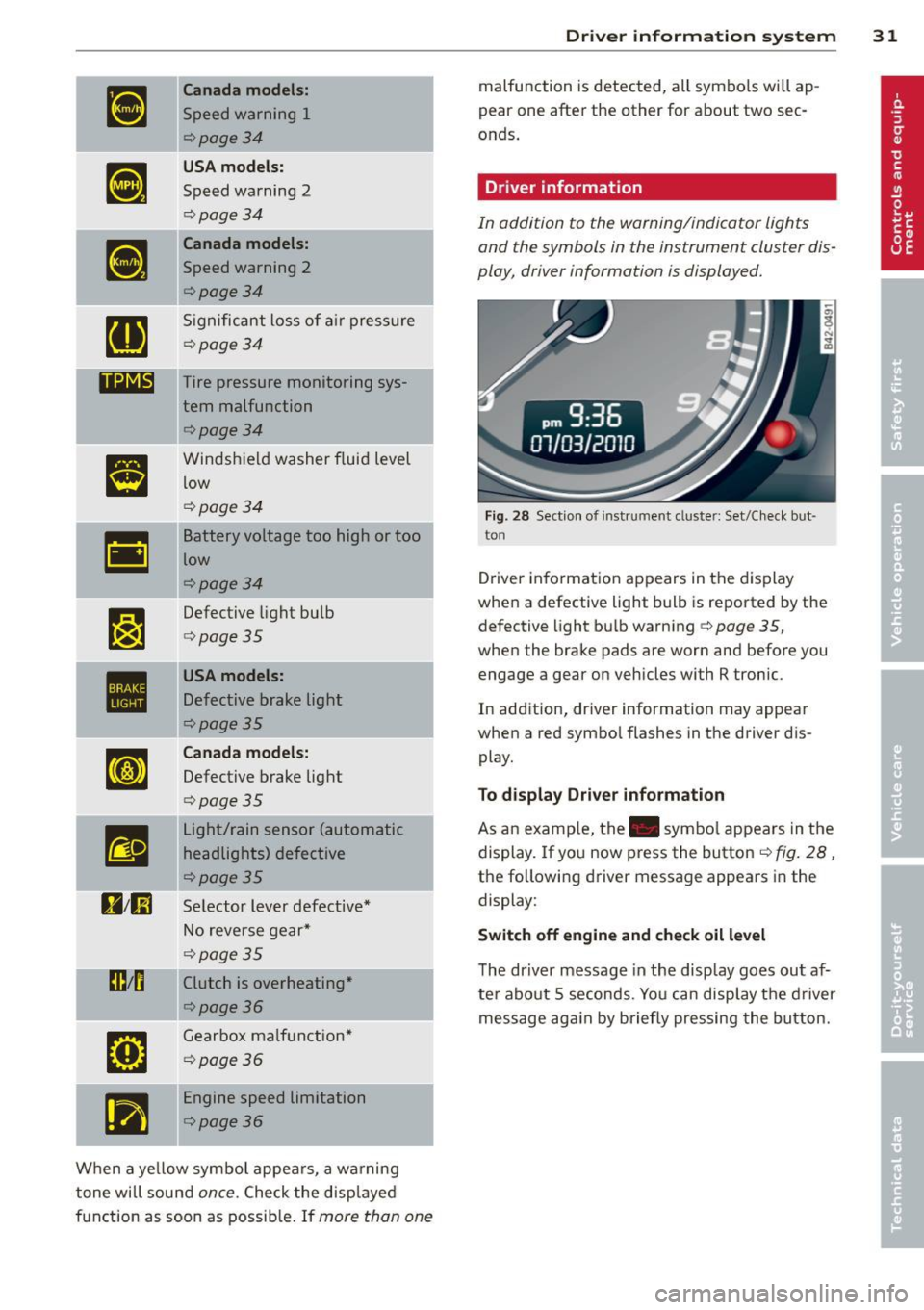
•
Canada models:
Speed warning 1
¢page34
•
USA mode ls:
Speed warning 2
¢page 34
•
Canada model s:
Speed warning 2
¢page34
RI
S ignificant loss of a ir pressure
¢page34
lliliE Tire pressure monitoring sys-
tern malfunction
¢page34
a
Windshield washer f luid level
low
¢page34
-
II Battery voltage too high or too
low
,. ¢page 34
~:~
Defective light bulb
¢page 35
•
lrusA models:
Defective brake light
9page35
•
Canada model s:
Defective brake light
c!>page35
m
Light/rain sensor (automatic
headlights) defective
¢page35
ll 11il Selector lever defective*
No reverse gear *
¢page 35
min Clutch is overheating*
¢page36
D
Gearbox ma lf u nction*
¢page 36
(a
II Engine speed limitation
ll¢page36
W hen a yellow symbo l appea rs, a wa rning
tone will sound
once. Check the disp layed
function as soon as possib le . If
more than one
Dr iver in formation system 31
malfunction is detected, all symbo ls wi ll ap
pear one after the other for about two sec
onds .
Driver information
In addition to the warning/indicator lights
and the symbols in the instrument cluster dis
play, driver information is displayed.
Fig. 2 8 Section of instrument cluster: Set/C heck but·
ton
Driver in format io n ap pears in the d is p lay
when a defective light bulb is reported by the
defective light bu lb warning ¢
page 35 ,
when the brake pads are worn and before you
engage a gear on vehicles with R tronic .
In addition, driver information may appear
when a red symbo l flashes in the driver dis
play.
To d isplay Driver information
As an examp le, the . symbo l appears in the
display. If you now press the button¢
fig. 28,
the following driver message appears in the
display:
Switch off engine and check oil le vel
T he dr iver message in the display goes out af
ter abo ut 5 seconds. Yo u can disp lay t he driver
message aga in by briefly pressing the button.
Page 38 of 244
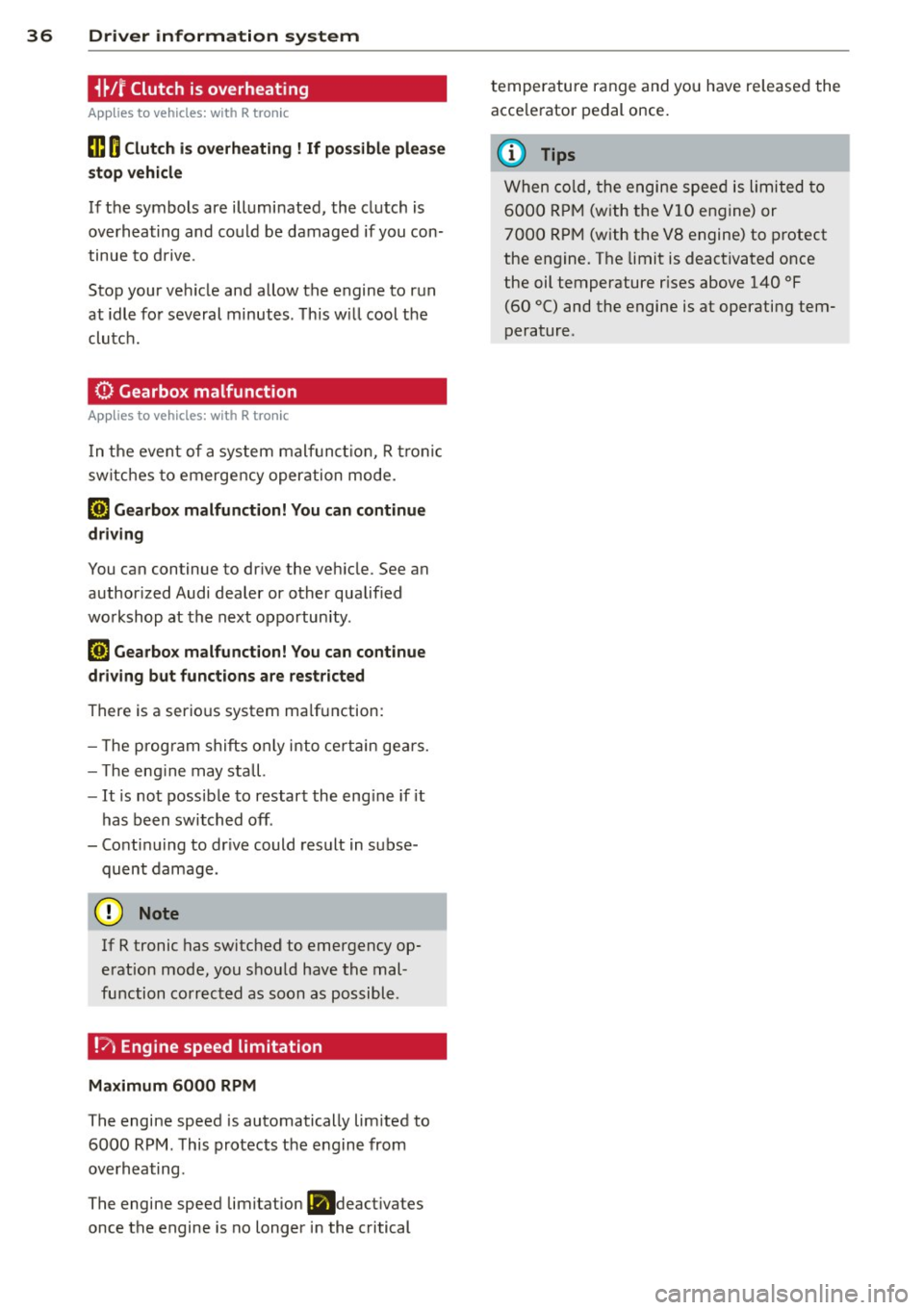
36 Driver information system
i~/r Clutch is overheating
Applies to vehicles: with R tronic
ffl O Clutch is overheating ! If possible please
stop vehicle
If the symbols are illuminated, the clutch is
overheating and could be damaged if you con
tinue to drive .
Stop your vehicle and allow the engine to run
at idle for several minutes . This will cool the
clutch.
0 Gearbox malfunction
Appl ies to vehicles: with R tronic
In the event of a system malfunction, R tronic
switches to emergency operation mode.
[O] Gearbox malfunction! You can continue
driving
You can continue to drive the vehicle. See an
author ized Audi dealer or other qualif ied
workshop at the next opportunity .
[O] Gearbox malfunction! You can continue
driving but functions are restricted
There is a serious system ma lfunction:
- T he prog ram shifts only into certain gears.
- T he eng ine may sta ll.
- It is not possible to restart the engine if it
has been switched off .
- Continuing to dr ive could result in subse
quent damage .
(D Note
If R tronic has switched to emergency op
eration mode, you should have the mal
function corrected as soon as possible.
!?) Engine speed limitation
Maximum 6000 RPM
The engine speed is automatically lim ited to
6000 RPM . This protects the engine from
overheating .
The engine speed limitation
(ll deact ivates
once the engine is no longer in the critical temperature range and you have released the
acce lerator pedal once.
(D Tips
When cold, the engine speed is limited to
6000 RPM (with the
VlO engine) or
7000 RPM (with the VS engine) to protect
the engine . The limit is deactivated once
the oil temperature rises above 140 °F
(60
°() and the engine is at operating tem
perature.
Page 74 of 244

7 2 Warm and cold
Warm and cold
Climate controls
Controls
The climate controls automatically maintain the selected temperature in the vehicle interior
throughout each season .
Fig. 82 Climate contro ls
We recommend the following sett ing :
> Rotate the knob 9 fig. 82 @ to the right to
switch on the air conditioning .
> Set the temperature to 72 °F (22 °().
> Press the !AUTO !~ fig. 82 button .
Using the previously recommended setting is
the quickest way to achieve a comfortable cli
mate in the vehicle . This setting should there
fore only be changed when persona l comfort
l evels or certain circumstances require it.
The climate controls are a combination of au
tomatic heating and ventilation systems and a
coo ling system which dehum idifies and coo ls
the air inside the veh icle.
The climate controls automatically maintain a temperature once it has been set . The tem
perat ure of the air from the vents, fan speed
(air volume) and a ir dist ribution are also auto
mat ical ly adjusted . The system also takes into
account strong s unshine so that manua l ad
justment is not necessary. So in almost all cases,
a ut om at ic mode offers the best condi
tions for the comfort of the occupants at all
times of the year
9 page 75 .
Plea se not e:
In cooling mode , relative humidity in the inte
rior is reduced . This prevents the w indows
from fogg ing up. When outside temperatures
are low (temperatures below freezing), the air
condit ion ing (compressor) switches off auto
matically - air in the vehicle inte rior is not de
humid ified.
When relative hum idity and temperatures
outside are h igh,
co nden sat e can drip from
the a ir cond ition ing evaporator and form a
pool of water under the vehi cle. This is normal
and not an ind ication of a leak!
When outs ide temperatures are low, the fan
doe s not switch to a h igher speed until the
coolant has reached an adequate tempera
tu re, with the exception of the defrost set
ting.
When accelerating at wide-open throttle, the air conditioning compressor is temporarily
switched off to maintain full eng ine power .
In order to ensure engine cooling under ex
t reme engine loads , the compressor is switch
ed off if coolant temperatures climb too high . .,..
Page 75 of 244
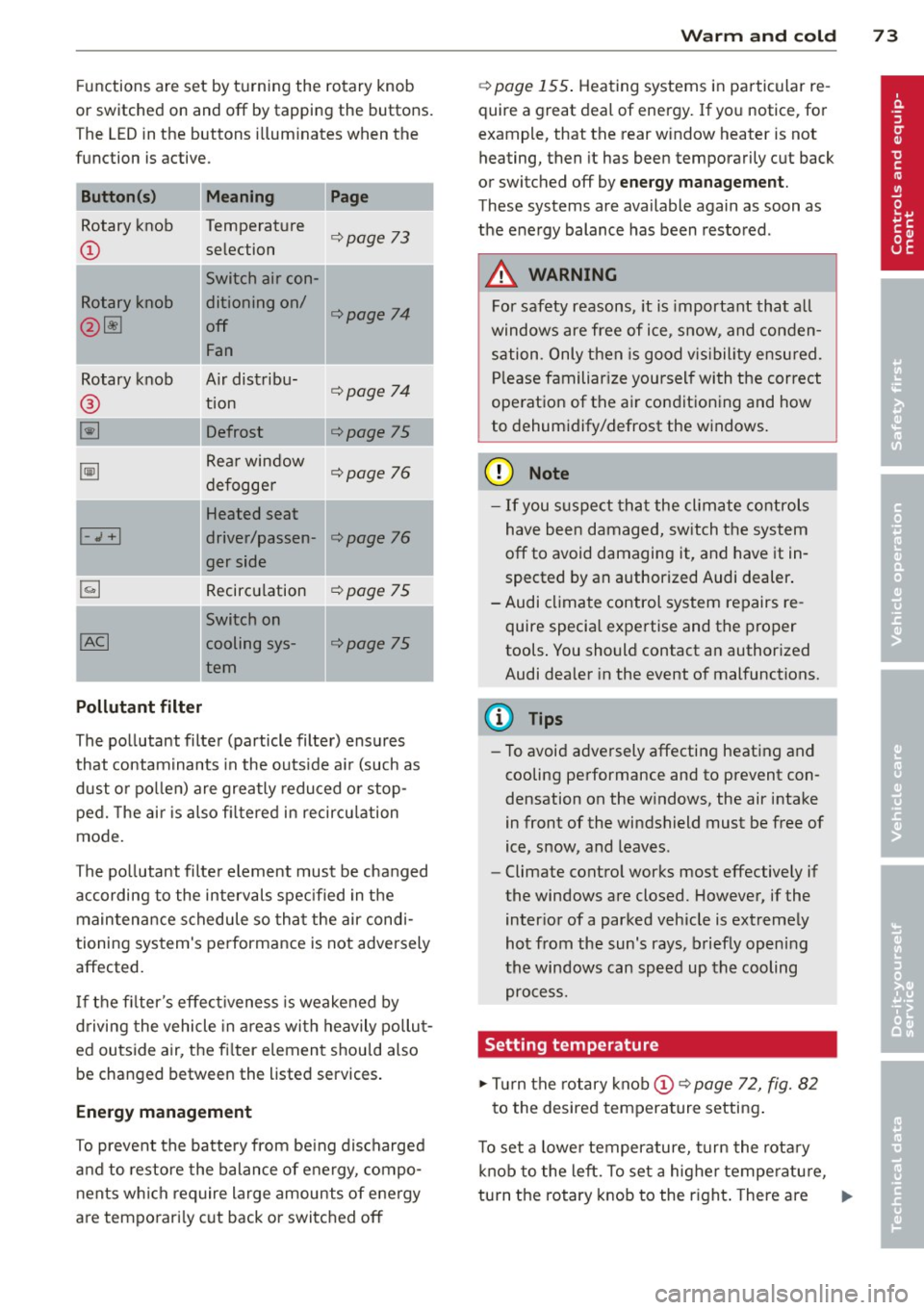
Functions are set by turning the rotary knob
or switched on and
off by tapping the buttons.
T he LED in the buttons illuminates when the
function is active.
Button(s) Meaning Page
Rotary knob Temperature
i::>page 73
CD selection
Switch air con-
Rotary knob ditioning on/
i::>poge 74
@ ~ off
Fan
Rotary knob Air distribu-
i::> page 74
® tion
~ Defrost i::>poge 75
~
Rear window i::>page 76
defogger
Heated seat
I-.1 + I driver/passen-i::>poge 76
ger side
Recirculation
i::> page 75
Switch on
! AC!
I
cooling sys-i::> page 75
tern
Pollutant filter
The pollutant filter (particle filter) ensures
that contaminants in the outside air (such as
dust or pollen) are greatly reduced or stop
ped. The air is also filtered in recirculation
mode.
The pollutant filter element must be changed according to the intervals specified in the maintenance schedule so that the air condi
tioning system's performance is not adversely
affected.
If the filter 's effectiveness is weakened by
driving the vehicle in areas with heavily pollut
ed outside air, the filter element should also
be changed between the listed services.
Energy management
To prevent the battery from being discharged
and to restore the balance of energy, compo
nents which require large amounts of energy
are temporarily cut back or switched
off
Warm and cold 73
i::> page 155. Heating systems in particular re
quire a great deal of energy. If you notice, for
example, that the rear window heater is not
heating, then it has been temporarily cut back
or switched
off by energy management.
These systems are available again as soon as
the energy balance has been restored .
A WARNING
For safety reasons, it is important that all
windows are free of ice , snow, and conden
sation . Only then is good visibility ensured.
Please familiarize yourself with the correct
operation of the air conditioning and how
to dehumidify/defrost the windows.
(D Note
- If you suspect that the climate controls
have been damaged, switch the system
off to avoid damaging it , and have it in
spected by an authorized Audi dealer.
- Audi climate control system repairs re quire special expertise and the proper
tools. You should contact an authorized
Audi dealer in the event of malfunctions.
(D Tips
-To avoid adversely affecting heating and
cooling performance and to prevent con
densation on the windows, the air intake
in front of the windshield must be free of
ice, snow, and leaves.
- Climate control works most effectively if
the windows are closed. However, if the
interior of a parked vehicle is extremely
hot from the sun's rays, briefly opening
the windows can speed up the cooling
process.
Setting temperature
.,. Turn the rotary knob CD c:> page 72, fig. 82
to the desired temperature setting.
To set a lower temperature, turn the rotary
knob to the left. To set a higher temperature,
turn the rotary knob to the right. There are .,..
Page 77 of 244
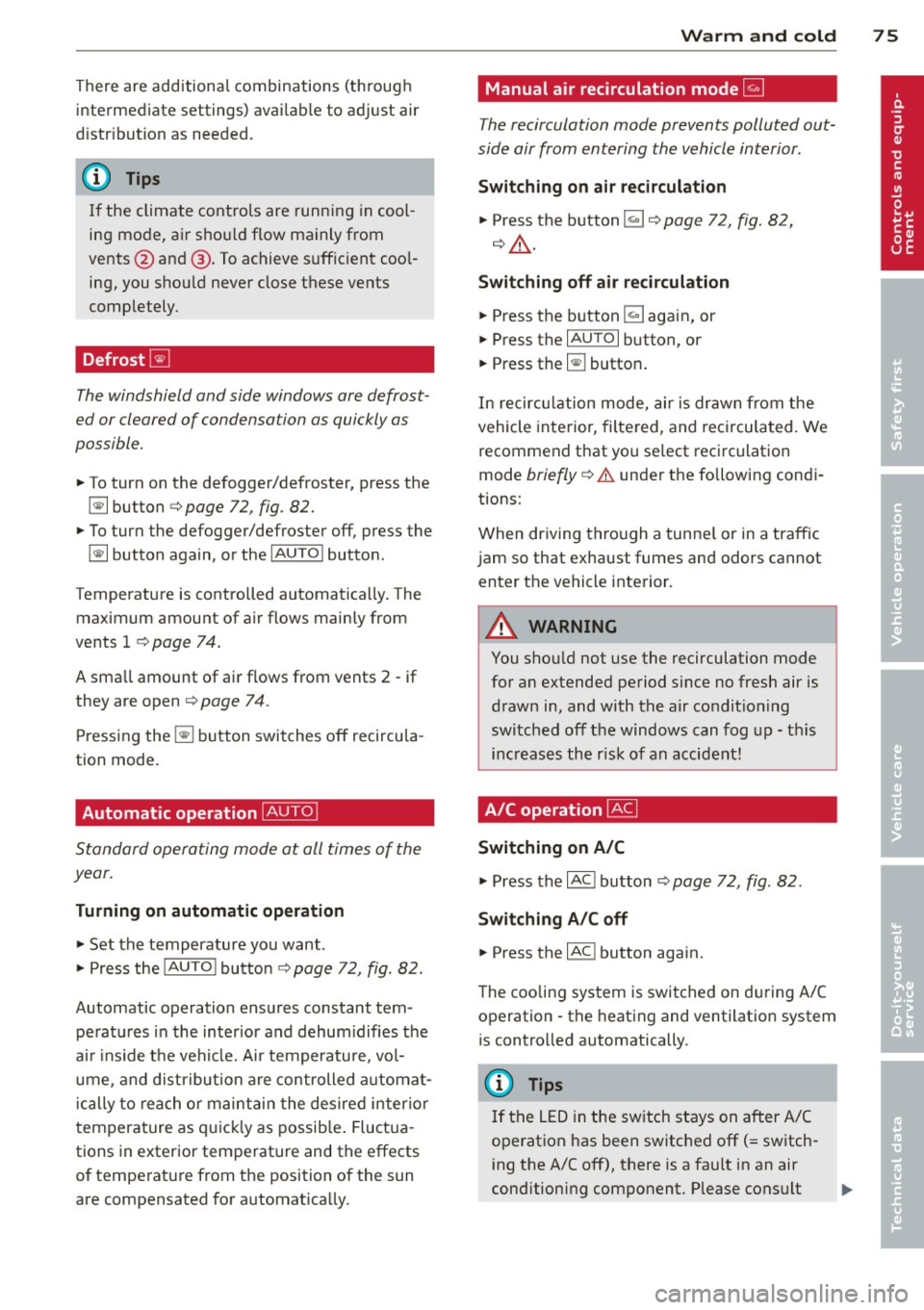
There are additional combinations (through
intermediate settings) avai lab le to adjust air
d istr ibution as needed.
(D Tips
I f the climate controls are running in cool
ing mode, air shou ld flow mainly from
vents @and
@. To achieve s uff ic ient coo l
ing, you shou ld never close these vents
completely.
Defrost ~
The windshield and side windows are defrost
ed or cleared of condensa tion as quickly as
possible.
~ To turn on the defogger/defroster, press the
~ button ¢ page 72 , fig . 82.
~ To turn the defogger/defroster off, press the
~ button again, or the IAU TOI button .
T emperature is controlled automatically. The
maximum amount of a ir flows mainly from
vents 1 ¢
page 74.
A small amount of air flows from vents 2 -if
they are open
¢ page 74 .
Pressing the~ button switches off recircu la
tion mode.
Automatic operation ~
Standard operating mode at all times of the
year.
Tu rning on automatic operation
~ Set the temperature you want .
~ Press the IAU TO I button ¢ page 72, fig. 82.
Automatic operation ensures constant tem
peratures in the inter ior and dehum idifies the
air ins ide the vehicle. Air temperature, vol
ume , and distribution are controlled automat
i cally to reach o r maintain the desired interior
temperature as q uickly as possib le. Fluctua
tions in exterior temperature and the effects
of temperature from the position of the sun
are compensated for automat ically.
Warm and c old 75
Manual air recirculation mode~
The recirculation mode prevents polluted out
side air from entering the vehicle interior.
S w itching on air re circul atio n
~ Press the button ~¢ page 72, fig. 82,
¢ ,&.
Switching off a ir re circulation
~ Press the button l.;., I again, or
~ Press the IAU TOI button , or
~ Press the~ button .
In recircu lation mode, air is drawn from the
vehicle interior, filte red, and recirculated . We
recommend that you se lect recirculation
mode
briefly ¢.& under the fo llowing condi
tions:
When driving through a tunne l or in a traffic
jam so that exhaust fumes and odors cannot enter the vehicle interior.
A WARNING
You shou ld not use the recirculation mode
for an extended period s ince no fresh air is
drawn in, and with the air condit ioning
switched off the windows can fog up -this
increases the r isk of an accident!
A/C operation ~
Switching on A /C
~ Press the IAC ! button ¢ page 72, fig. 82.
Sw itching A /C off
~ Press the IAC ! button again.
The cooling system is switched on during A/C
operation -the heating and ventilation system
is controlled automatically .
(D Tips
If the LED in the switch stays on after A/C
operation has been switched off( = switch-
ing the A/C off), there is a fault in an air
cond itioning component. Please consult
llJI,
Page 78 of 244
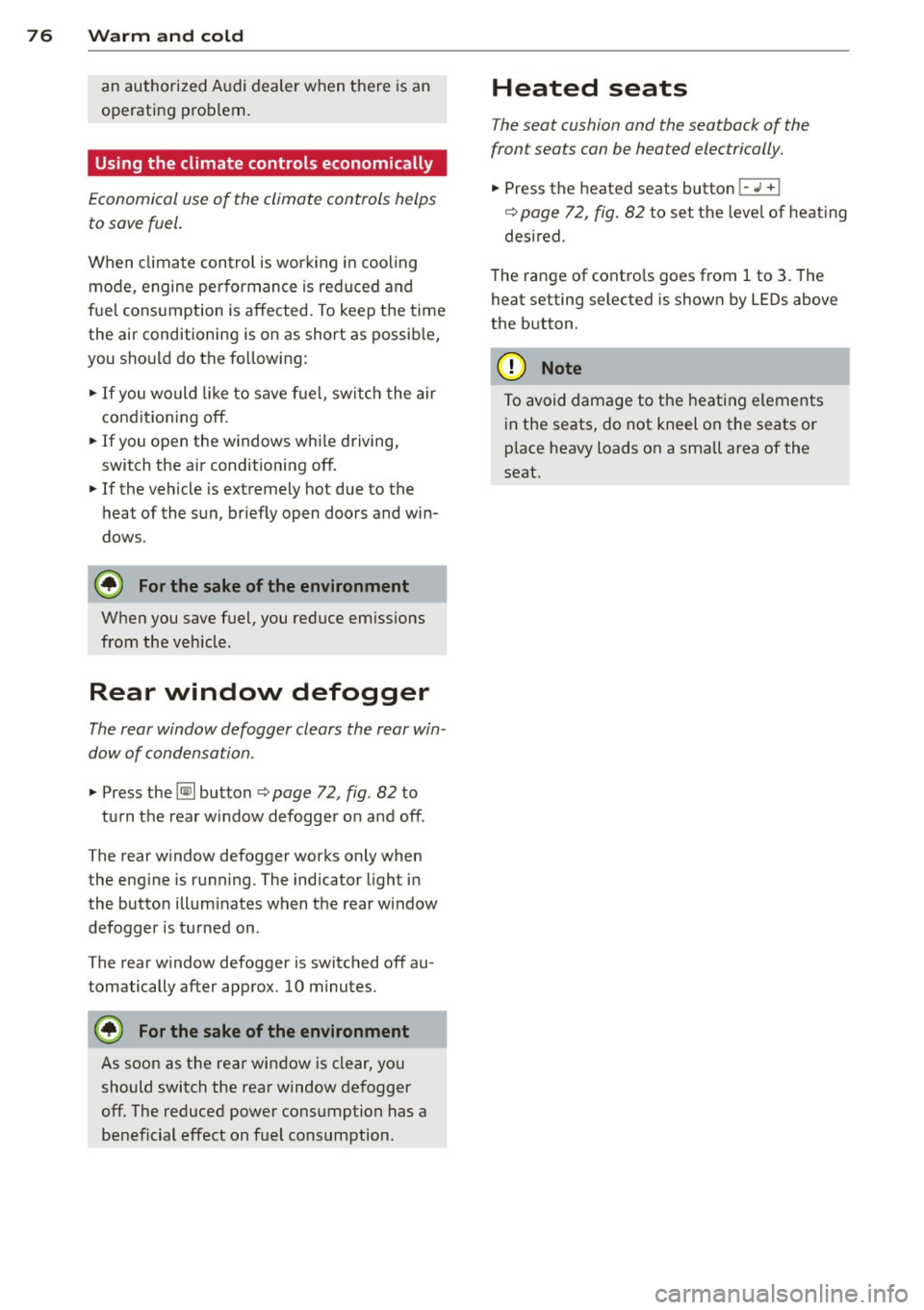
76 Warm and cold
an authorized Audi dealer when there is an
operating problem.
Using the climate controls economically
Economical use of the climate controls helps
to save fuel.
When climate control is wor king in cool ing
mode, engine performance is reduced and
fuel consumption is affected. To keep the time
the air conditioning is on as short as possible,
you shou ld do the fo llow ing:
.,. If you would like to save f uel, sw itch the air
condition ing off.
... If you open the windows whi le driving,
switch the air conditioning off.
... If the vehicle is extremely hot due to the
heat of the sun, briefly open doors and win
dows .
@ For the sake of the environment
When you save fuel, you reduce emissions
from the vehicle.
Rear window defogger
The rear window defogger clears the rear win
dow of condensation .
... Press the~ button c::> page 72, fig. 82 to
turn the rear window defogger on and off.
The rear window defogger works only when
the eng ine is running. The indicator light in
the butto n illum inates when the rear window
defogger is turned on .
The rear window defogger is switched off au
tomatically after approx. 10 minutes.
@ For the sake of the environment
As soon as the rear window is clear, yo u
should switch the rear window defogger
off. The reduced power consumption has a
beneficial effect on fuel consumption.
Heated seats
The seat cushion and the seotbock of the
front seats con be heated electrically.
... Press the heated seats button I- ., +I
c::> page 72, fig . 82 to set the level of heating
desired.
The range of contro ls goes from 1 to 3. The
heat setting selected is shown by LEDs above
the button.
(D Note
To avoid damage to the heating elements
in the seats, do not kneel on the seats or
place heavy loads on a small area of the
seat .
Page 153 of 244
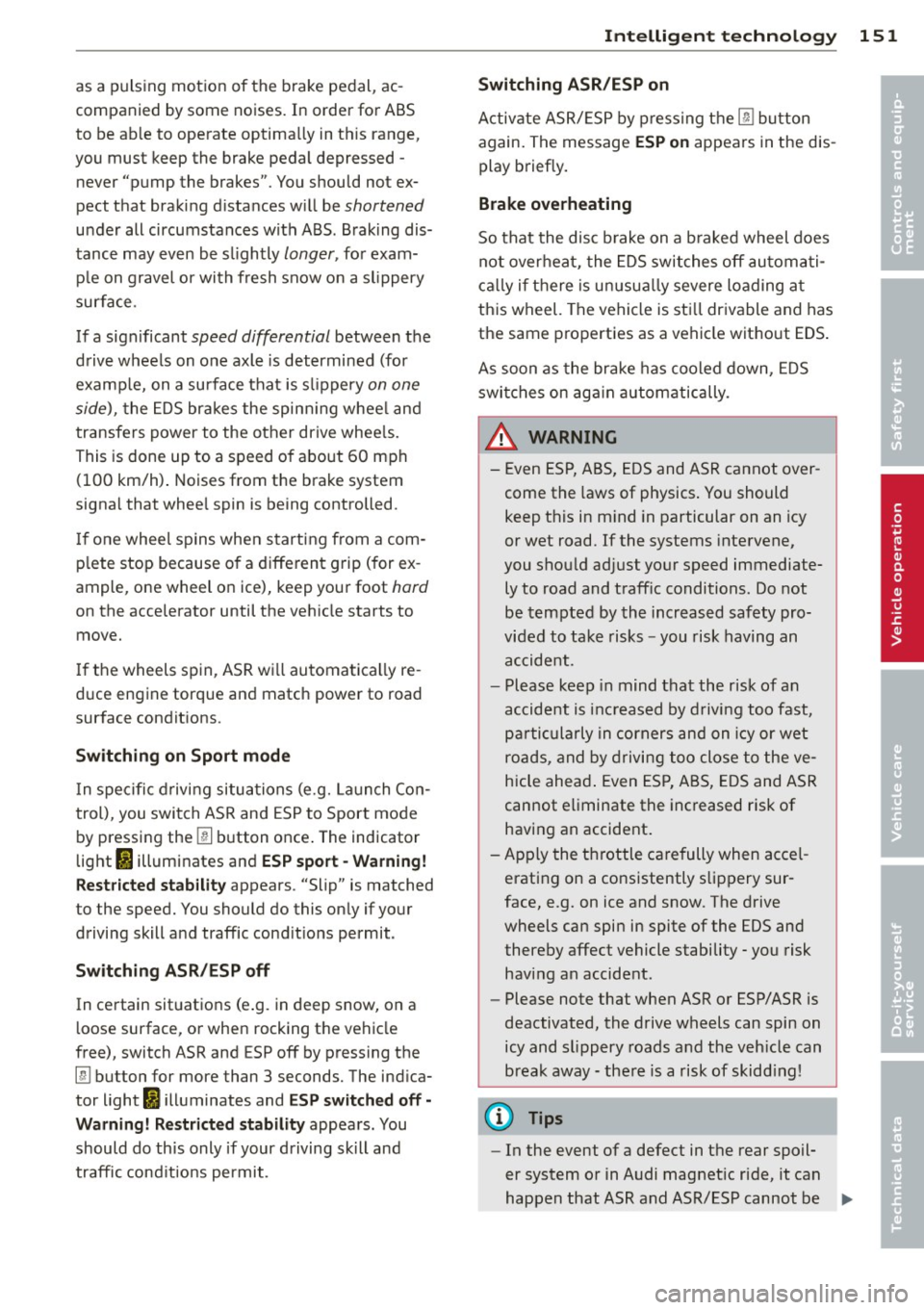
as a pulsing motion of the brake pedal, ac
companied by some noises. In order for ABS
to be able to operate optimally in th is range,
you must keep the brake pedal depressed -
never "pump the brakes" . You should not ex
pect that braking d istances w ill be
shortened
under all circumstances with ABS . Braking dis
tance may even be slightly
longer, for exam
p le on gravel or wi th fresh snow on a slippery
surface .
If a sign ificant
speed differential between the
d rive wheels on one axle is determined (for
examp le, on a su rface that is s lippery
on one
side),
the EDS brakes the spinn ing whee l and
transfers power to the other drive whee ls.
This is done up to a speed of about 60 mph (100 km/h) . Noises from the brake system
signal that whee l spin is being controlled.
I f one whee l spins when starting from a com
p lete stop because o f a different grip (for ex
ample , one wheel o n ice), keep your foot
hard
on the accelerator until the veh icle starts to
move.
If the wheels spin , ASR wi ll automatically re
duce engine torque and match power to road
surface conditions .
Switching on Sport mod e
In specific driving situations (e.g. Launch Con
trol), you swi tch ASR and ESP to Sport mode
by pressing the
[!I button once . The indicator
light
11 illuminates and ESP sport -Wa rni ng!
Restric ted stab ility
appears . "Slip" is matched
to the speed. You should do this only if your
driving skill and traffic cond it ions permit .
Switching ASR /ESP off
In certain sit uations (e .g . in deep snow, on a
l oose surface, o r when rocking the vehicle
free), switch ASR and ESP off by pressing the
[ill button for more than 3 seconds. The ind ica
tor light
I) illuminates and ES P sw itc hed off -
Warning! R estricted stability
appears . You
should do th is only if your driving skill and
traffic cond itions pe rmit .
Int ellig ent technolog y 151
Switching ASR /ESP on
Activate ASR/ ESP by p ressing the [!I button
again. The message
ESP on appears in the d is
play briefly.
Brake overheating
So that the disc b rake on a b raked wheel does
not overheat, the EDS switches off automati
ca lly if there is un usua lly severe loa ding at
th is wheel. The vehicle is st ill drivable and has
the same properties as a vehicle wit hout EDS .
As soon as the brake has cooled down, EDS
swi tches on aga in automatically.
A WARNING
- Even ESP, ABS, EDS and ASR cannot over
come the laws of physics . You should
keep this in m ind in particular on an icy
or wet road. If the systems intervene,
you shou ld adjust your speed immediate
ly to road and traff ic conditions . Do not
be tempted by the increased safety pro
vided to take risks -you risk having an
accident.
- Please keep in mind that the r isk of an
accident is i ncreased by driving too fast,
pa rti cularly in corners and on icy or wet
ro ads, and by drivi ng too close to the ve
hicle ahead . Even ES P, ABS, E DS and ASR
cannot eliminate the increased risk of
having an accident.
-Apply the throttle ca re fully when accel
erating on a consistently s lippery sur
face, e.g. on ice and snow . The drive
wheels can spin in spite of the EDS and thereby affect vehicle stability -you risk
having an accident .
- Please note that when ASR or ESP/ASR is
deactivated, the drive wheels can spin on
icy and slippery roads and the veh icle can
break away -the re is a risk of skidd ing!
(D Tips
- In the event of a defect in the rear spoil-
er system or in Audi magnet ic ride, it can
happen that ASR and ASR/ESP cannot be .,.
•
•
Page 158 of 244
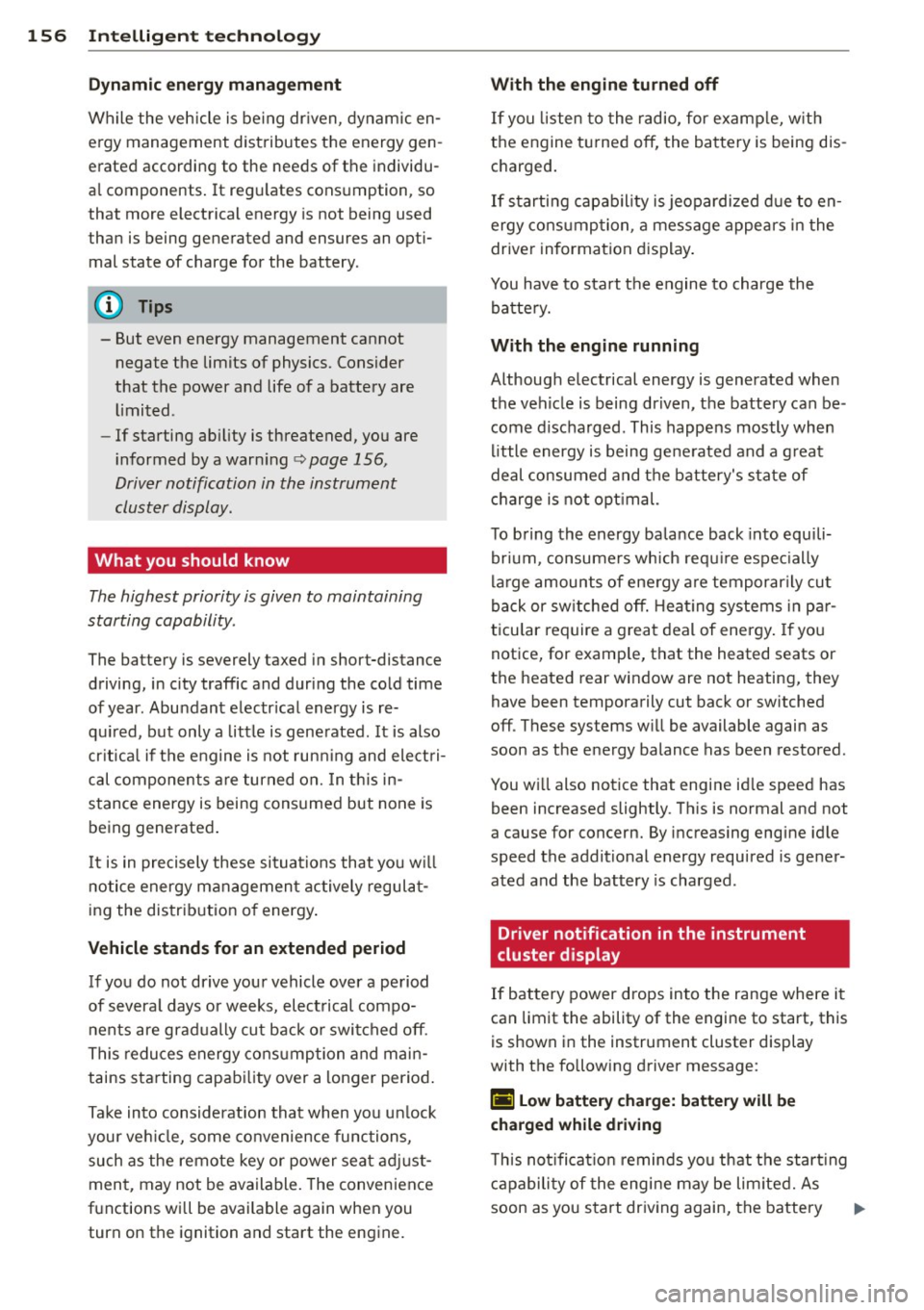
156 Intelligent technology
Dynamic energy management
While the veh icle is be ing driven , dynamic en
e rgy management distributes the energy gen
erated according to the needs of the individu
a l components . It regu lates consumption, so
that more electrical energy is not being used
than is being generated and ensures an opti mal state of charge for the battery .
(D Tips
- But even energy management cannot
negate the limits of physics. Consider
that the power and life of a battery are li mited .
- If starting ab ility is threatened, you are
i nformed by a warn ing
<=> page 156,
Driver notification in the instrument
cluster display .
What you should know
The highest priority is given to maintaining
starting capability.
The battery is severely taxed in short-distance
driving, in city traffic and during the cold time
of year. Abu ndant electr ical energy is re
qu ired, but only a little is generated . It is also
cr itical if the engine is not running and elect ri
cal components are turned on. In th is in
stance energy is being consumed but none is
being generated .
It is in precisely these situations that you w ill
notice energy management actively regulat
ing the distrib ution of energy .
Vehicle stands for an extended period
If you do not drive your vehicle over a period
of severa l days or weeks, elect rical compo
nents are gradually cut back o r switched off .
This reduces energy consumption and main
tains starting capabi lity over a longer period.
Take into considerat ion that when you un lock
your vehi cle, some convenience functions,
such as the remote key or power seat adjust
ment, may not be available. The convenience
functions will be available again when you
turn on the ignition and start the engine. With the
engine turned off
If you listen to the radio, for examp le, w ith
the engine turned off, the battery is being dis
charged.
If starting capability is jeopardized due to en
ergy consumption , a message appea rs in the
driver information display.
You have to start the engine to charge the batte ry.
With the engine running
Although electrical energy is generated when
the vehicle is being driven, the battery can be
come discharged. This happens mostly when
little energy is being gene rated and a great
deal consumed and the battery's state of
charge is not optimal.
To bring the energy balance back into equili
brium , consume rs which requ ire espec ially
large amounts of energy are temporar ily cut
back or sw itched off. Heating systems in par
ticu lar require a great deal of energy. If you
notice, for example, that the heated seats or
the heated rear window are not heating, they
have been temporarily cut back or switched
off . These systems will be available again as
soon as the ene rgy balance has been restored.
You wi ll also notice that engine id le speed has
been increased slightly . Th is is normal and not
a cause for concern. By increasing engine idle
speed the additional energy required is gene r
ated and the battery is charged .
Driver notification in the instrument
cluster display
If battery power drops into the range where it
can limit the ability of the engine to start, this
is shown in the instrument cluster display
with the following driver message:
(•i Low battery charge: battery will be
charged while driving
T h is not ificat io n r eminds you that the start ing
capability of the engine may be lim ited. As
soon as you start driving again, the battery .,..
Page 160 of 244
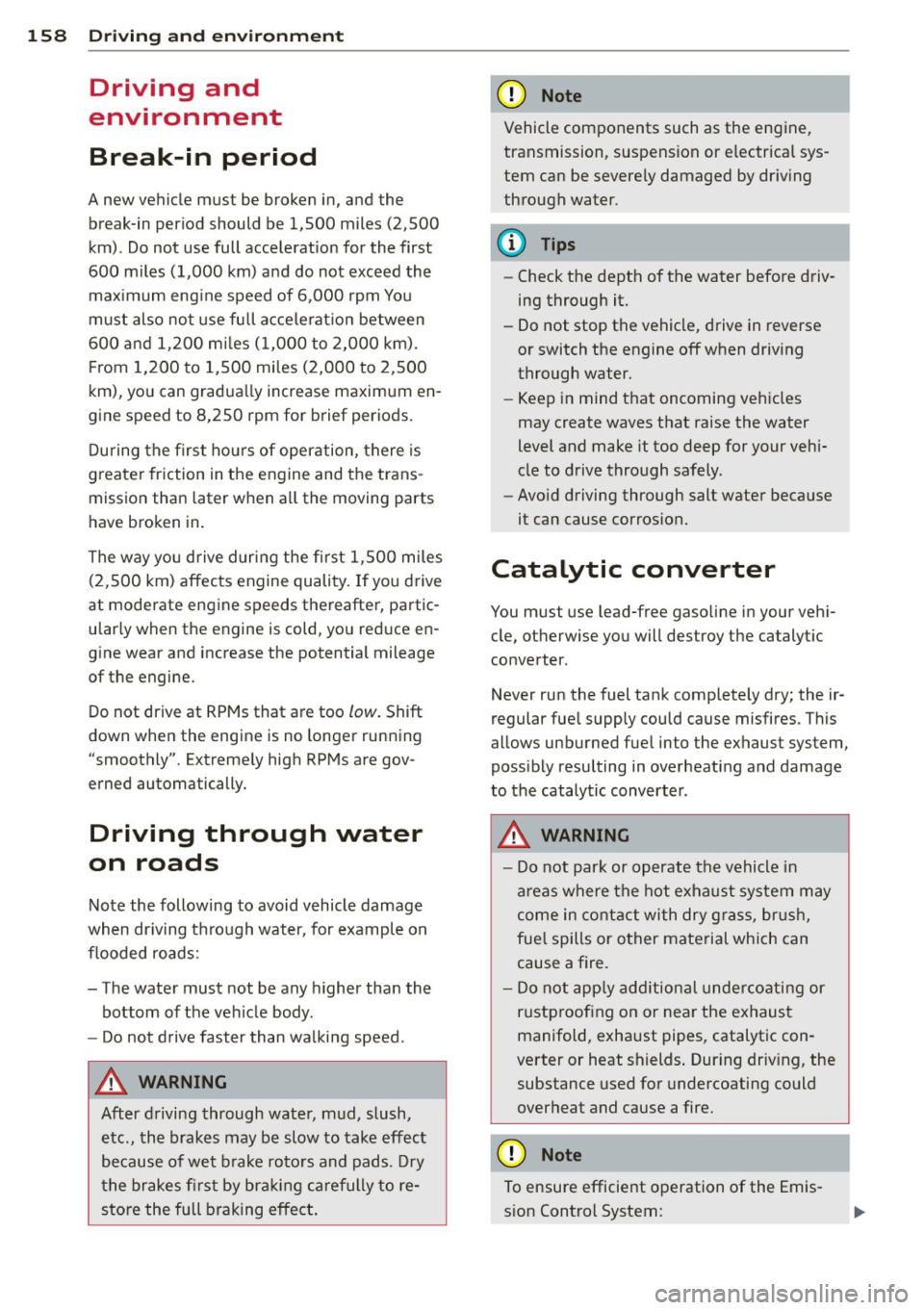
158 Driving and en vi ro nm ent
Driving and
environment
Break-in period
A new vehicle must be broken in, and the break-in per iod should be 1,500 miles (2,500
km) . Do not use full acceleration for the first
600 miles (1,000 km) and do not exceed the
maximum eng ine speed of 6,000 rpm You
must also not use fu ll acce lerat ion between
600 and 1,200 mi les (1,000 to 2,000 km).
F rom 1,200 to 1,500 mi les (2,000 to 2,500
km), you can gradua lly increase maxim um en
gine speed to 8,250 rpm for brief periods.
During the first ho urs of operation, there is
g reater friction in the engine and the trans
mission than later when a ll the moving parts
have broken in.
The way yo u drive duri ng the first 1,500 miles
(2,500 km) affects engine quality. If you drive
at moderate engine speeds thereafter, partic
u lar ly when the engine is cold, yo u reduce en
g ine wear and increase the potential mileage
of the engine.
Do not drive at RPMs that are too low. Shift
down when the engine is no longer running
"smoothly". Extreme ly high RPMs are gov
erned automatically.
Driving through water
on roads
Note the following to avoid vehicle damage
when dr iving through water, for example on
flooded roads:
- The water must not be any higher than the
bottom of the vehicle body .
- Do not drive faster than wa lking speed.
.&_ WARNING
After driving through water, mud, slush,
etc., the brakes may be slow to take effect
because of wet b rake roto rs and pads. Dry
t he brakes fi rst by bra king carefully to re
sto re the full braking effect.
-
(D Note
Vehicle components such as the eng ine,
transmission, suspension or e lectrical sys
tem can be severe ly damaged by dr iv ing
through water.
@ Tips
- Check the depth of the water before d riv
ing through it.
- Do not stop the vehicle, drive in reverse
or switch the engine off when driving
through water.
- Keep in mind that oncoming vehicles
may create waves that raise the water
level and make it too deep for your vehi
cle to drive through safely .
- Avo id driving through salt water because
it can cause corros ion.
Catalytic converter
You must use lead-free gasoline in your veh i
cle, otherwise you will destroy the catalyt ic
converter.
Never run the fuel tank completely dry; their
regular fuel supply could cause misfires . This
allows unburned fuel into the exhaust system,
poss ibly resulting in overheating and damage
to the catalytic converter .
.&_ WARNING ,-
-Do not park or operate the vehicle in
areas where the hot exha ust system may
come in co nta ct with dry g rass, brush,
fue l spills or o ther material which can
cause a fire.
- Do not app ly addition al under coating or
r u stproofing on or nea r the exhaust
manifold, exhaust pipes, catalytic con
verter or heat shields . Dur ing driving, the
substance used for undercoating could
overheat and cause a fire.
(D Note
To ensure efficient o peration of the Emis
s ion Control System:
Page 183 of 244
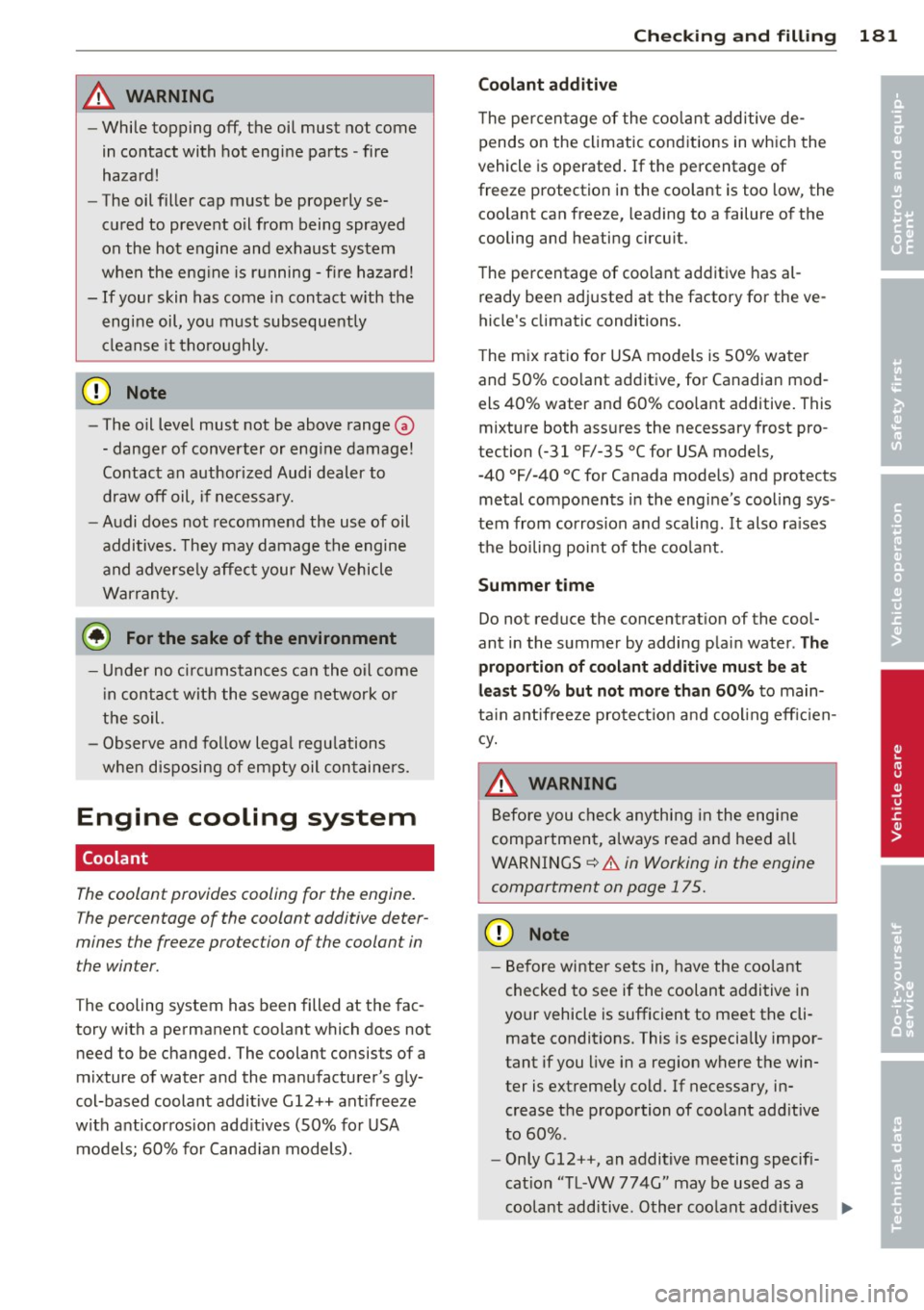
A WARNING ,~
- While topping off, the oil must not come
in contact with hot engine pa rts -fire
hazard!
- The oil fil ler cap must be properly se
cured to prevent oil from being sprayed
on the hot engine and exhaust system
when the eng ine is running -fire hazard!
- If your skin has come in contact w ith the
engine oil, yo u must subsequently
cl eanse it tho roughly.
CD Note
- The oil level must not be above range G)
- danger of converter or eng ine damage!
Contact an authorized Audi dealer to
draw off oil, if ne cessa ry.
- Audi does not recommend the use of oil
additives. They may damage the engine
and adverse ly affect your New Vehicle
Warran ty.
@) For the sake of the environment
- Under no ci rcumstances ca n the oil come
i n conta ct wit h the sewage network o r
the soil.
- Observe and fo llow lega l regu lations
when d isposing of empty oil con taine rs.
Engine cooling system
Coolant
The coolant provides cooling for the engine.
The percentage of the coolant additive deter
mines the freeze protection of the coolant in the winter.
The cooling system has been filled at the fac
tory with a permanent coo lant which does not
need to be changed. The coolant consists of a
mixture of water and the manufacturer's gly
col-based coolant additive Gl2++ ant ifreeze
with ant icor rosion add itives (SO% fo r USA
models; 60% for Canad ian models).
Checkin g and fillin g 181
Coolant additive
The percentage of the coo lant add itive de
pends on the climatic cond itions in wh ich the
vehicle is operated . If the percentage of
freeze protection i n the coo lant is too low, the
coolant can freeze, leading to a failure o f the
cooling and heating circuit.
T he percentage of coolant addit ive has al
ready been adjusted at the factory for the ve
hicle's climatic conditions.
T he m ix rat io for USA models is SO% wa ter
and SO% coolant addit ive, for Canadia n mod
els 40% water and 60% coolant additive. This
mixture both ass ures the necessary frost pro
tection (-31 °F/-3S °C for USA models, -40 °F/-40 °C for Canada models) a nd protects
metal components i n the engine's cooling sys
tem from corrosion and scaling. It also ra ises
t h e boili ng poi nt of the coo la nt.
Summer time
Do not reduce the concentrat ion of the cool
ant in the summer by adding p la in water.
The
proportion of coolant additive must be at
least 50 % but not more than 60 %
to main
ta in an tifreeze pro te cti on and cooling eff ic ien
c y.
A WARNING
B efore you c hec k anything in the engi ne
compartment, a lways rea d and heed a ll
WAR NIN GS~ .&.
in Working in the engine
compartment on page 175.
CD Note
- Be fore winter sets in, have the coo lant
checke d to see if the coolan t additive in
your vehicle is sufficient to meet the cli mate conditions. This is especia lly impor
tant if you live in a region where t he win
ter is extreme ly cold. If necessary, in
crease the p ropo rtion of coo lant add itive
to 60% .
-
-Only Gl2+ +, an additive meeting specif i
cat io n "T L-VW 774G" may be used as a
coolant additive. Oth er coo lant add itives
IJJ,
•
•